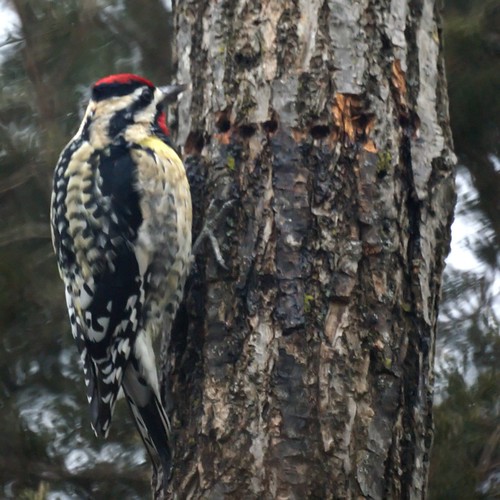As we get all excited about the sap running, so do other critters. Perhaps first among them is the yellow-bellied sapsucker, who winters in the south. Around now, the sapsuckers start migrating north, following this rich food source as each successive latitude warms up enough to start the flow.
Sapsuckers make a series of round holes in a tree's bark, usually lined up in efficient little rows. They then lap up the sap that comes out -- sometimes returning to holes over and over as the sap continues to ooze.
In addition to their their distinctive holes, sapsuckers are a distinctive-looking bird. Like other woodpeckers, they've got mottled black and whitish feathers on their back and wings. Both males and females have a red spot on the top of their head; males also have a red throat. The belly has just a hint of yellow that you won't be able to detect without exactly the right light -- the picture above may be the yellowest I've ever seen.
The yellow-bellied sapsucker is considered a "keystone" species by some ecologists because many other birds rely on them. It's a hard time of year to find food, and other species -- including kinglets, warblers, phoebes, and even hummingbirds -- will follow behind the sapsuckers to lap up sap or insects.
But sapsuckers don't subsist entirely on sugar -- good thing, because the sap doesn't flow all year. The sapsucker may also make rectangular holes that allow them to get to the tree's phloem, which they eat. And, like other woodpeckers, they eat a lot of insects. Even when the sap is running, many insects either get uncovered by drilling into the tree, or are themselves attracted to the sap.
But no other woodpecker in our area makes such systematic holes in the trees. If you see a tidy little row, it was probably a sapsucker.
In the wild: You can find sapsuckers throughout the open woods of our region. If you see some holes actively oozing sap, hang out quietly for a little while and see who comes by.
In your yard: Don't worry, sapsuckers generally do not cause serious damage to trees -- the wounds they make are pretty shallow. Sapsuckers come to the large oak tree in our backyard all the time, and it's going strong.
We read of one photographer who attracted sapsuckers to his yard by drilling holes in an upright log and filling them with corn syrup. Cheating? You decide. It must have been quite a sugar rush for the birds!
Have you seen sapsuckers lately? Let us know.
Like the photos in this post? Mouse over for credits; a click takes you to the photographer on Flickr.
skip to main |
skip to sidebar
Recent Posts
Popular
Car-Free DC: Ten Great Places to Hike Around DC by Public Transportation (and Counting)
Car-Free DC: Rock Creek Park
LOOK FOR: Monarch Caterpillars (and Raise Them!)
Getting Kids Into Nature: Great Websites
Car-Free DC: Glover Archbold Park
LOOK FOR: Sumac Berries
Scott's Run Nature Preserve
Attachment to Nature Parenting: 10 Tools to Give Kids a Passion for Nature
Patuxent River Park: Jug Bay Natural Area
Car-Free DC: Rock Creek Park
LOOK FOR: Monarch Caterpillars (and Raise Them!)
Getting Kids Into Nature: Great Websites
Car-Free DC: Glover Archbold Park
LOOK FOR: Sumac Berries
Scott's Run Nature Preserve
Attachment to Nature Parenting: 10 Tools to Give Kids a Passion for Nature
Patuxent River Park: Jug Bay Natural Area
Comments
Links & Tweets
Twitter Updates
Calendar
We don't check for updates - you may want to check in with the trip leaders or sponsoring organizations!
Key: volunteering - kids & families - everything else
Archive
-
▼
2010
(34)
-
▼
March
(13)
- LOOK FOR: Bloodroot, a Delicate White Flower with ...
- C&O: the McKee-Beshers Wildlife Management Area
- Calendar: Learn About Native Plants, and Buy Some
- LOOK FOR: Spicebush Flowers, North America's Answe...
- Learn Your Wildflowers and Wild Edibles: Sign Up f...
- Calendar: The Potomac Heritage Trail
- LOOK FOR: Fairy Spuds, More Commonly Known as Spri...
- In pictures: Waiting for Spring
- Environmental Film Festival: March 16-28
- Calendar: Visit Two Threatened Creeks
- LOOK FOR: Yellow-Bellied Sapsuckers
- In Pictures: Thaw
- New & Improved Natural Capital: Thanks for Your Fe...
-
▼
March
(13)





